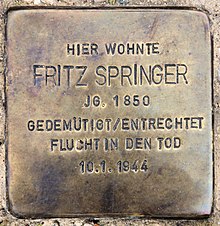Fritz Springer (publisher)
Fritz Springer (born December 3, 1850 in Berlin ; † January 10, 1944 there ) was a German publisher .
youth
Fritz Springer was the second eldest son of the bookseller and publisher Julius Springer and his wife Marie, nee. Oppert. After graduating from high school in 1869 and participating in the Franco-Prussian War as a volunteer with the guardsmen , Springer followed his technical-mathematical inclination and trained at the Ohm & Co machine factory in Berlin.
From 1873 to 1876, Springer went to Karlsruhe to study engineering at the Polytechnic School , the leading German training center for mechanical engineers at the time . After returning from Karlsruhe, he worked for two years at Berliner Maschinenbau AG, previously L. Schwartzkopff .
As early as 1878, one year after his father's death, his brother Ferdinand Springer senior , who had succeeded him at "Verlag von Julius Springer" (today Springer Science + Business Media ), won him over to work together at the publishing house. To do this, Fritz Springer had to do internships at befriended bookstores and publishers. In the Pierersche Hofbuchdruckerei in Altenburg he acquired printing skills. In 1879 he married Emma Hertz, daughter of the Berlin publisher Wilhelm Hertz and granddaughter of Adelbert von Chamisso .
Publishing activity
On January 1, 1880, Fritz Springer became a partner in the publishing house. The focus of his work was the technology program, which grew into the most important publishing branch within a few years and promoted and accompanied industrialization in Germany. The work of the two authors from the publishing house Werner von Siemens and Rudolf Diesel , whose flexible motors replaced the steam engine , had worldwide significance . After Springer's father Julius had published a first report on telegraph construction by the then largely unknown engineer Werner Siemens in 1851 and after Siemens had laid the foundations of electrical engineering in 1866 with the scientific justification of the dynamo-electric principle , Fritz Springer now also published his main works and finally the "Memoirs "by Werner von Siemens. Rudolf Diesel published the basic work Theory and Construction of an Rational Heat Engine to replace the steam engine and the combustion engines known today by Springer at about the same time as the patent was granted for the diesel engine.
A number of standard works that have been constantly updated, expanded and reissued, among them the classic Landolt-Börnstein , which is now published in English and is the largest data collection of its kind in the world, testify to Fritz Springer's publishing vision . Fritz Springer's merits were recognized by the TH Dresden in 1917 with the award of Dr. Ing. E. H. appreciated.
In 1881, the two brothers introduced the publisher's signet based on a design by Martin Gropius : a cartouche crowned by the chess jumper with the motto “All the time awake”, the founding year 1842 and the initials JS in memory of their father Julius Springer.
After more than 25 years of working together, the brothers Ferdinand and Fritz agreed that their eldest sons, Ferdinand Springer junior and Julius Springer d. J. to join the publishing house (1904) and to make them partners (1906). When Ferdinand senior died shortly afterwards, Fritz also withdrew from day-to-day business. He became the general representative of the publishing house and was able to take over the management again in 1914/1918 when his son and nephew were doing their military service. Fritz Springer stood by the two younger boys for decades in difficult decisions and relieved them by maintaining contacts with associations, authorities and the German Book Trade Association .
Persecution and death
At the old age of 94, Fritz Springer, like his 84-year-old brother Ernst Springer, fell victim to National Socialism. Before he was threatened with deportation to the Theresienstadt ghetto , he took poison and died on January 10, 1944 (Stolperstein Strasse zum Löwen 12). He is buried in the Wannsee II cemetery. Ernst Springer died in Theresienstadt.
Honors
- 1917 Awarded the Dr.-Ing. e. H. of the TH Dresden
Web links
literature
- Heinz Sarkowski: The Springer publishing house. Stations in its history. Part I: 1842-1945. Berlin 1992, ISBN 3-540-55221-9 .
- Heinz Götze: The Springer publishing house. Stations in its history. Part II: 1945-1992. Berlin 1994, ISBN 3-540-56691-0 .
- Ursula Springer: The History of Springer Publishing Company. New York 2008, ISBN 0-8261-1112-2 .
- Julius Springer's publishing catalog 1842–1911.
- History of the publishers Ferdinand and Fritz Springer, special exhibition 2000–2006 in the house of the Wannsee Conference
| personal data | |
|---|---|
| SURNAME | Springer, Fritz |
| BRIEF DESCRIPTION | German publisher |
| DATE OF BIRTH | December 3, 1850 |
| PLACE OF BIRTH | Berlin |
| DATE OF DEATH | January 10, 1944 |
| Place of death | Berlin |

